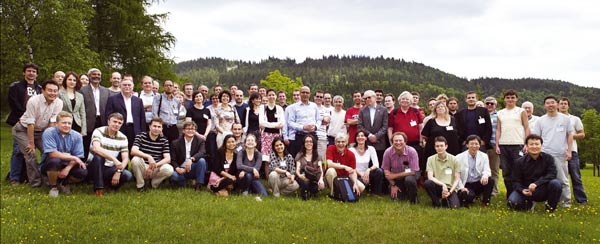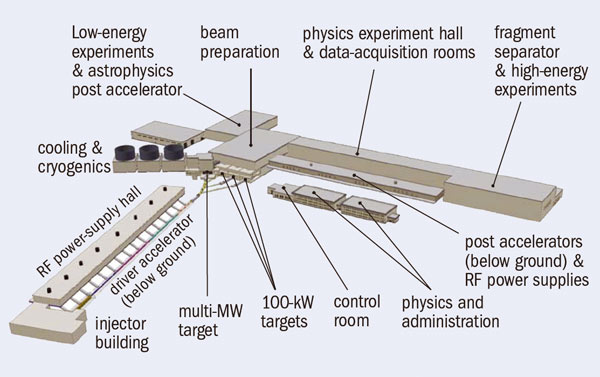The EURORIB ’10 conference looked forward to an exciting time with radioactive ion beams.

These are exciting times for European nuclear physics, with several new facilities under study or under construction, including HIE-ISOLDE at CERN, the NuSTAR experiments at the Facility for Antiproton and Ion Research (FAIR) in Germany, the Selective Production of Exotic Species (SPES) project at the Legnaro National Laboratory in Italy and the Système de Production d’Ions Radioactifs en Ligne 2 (SPIRAL2) at the French national heavy-ion accelerator laboratory, GANIL. In addition, the nuclear-physics community is working on a common design for a future European isotope-separation on-line facility, EURISOL. To discuss the open issues and promote synergies among the different projects, the community met recently at the second European Radioactive Ion Beam Conference (EURORIB ’10), held in Lamoura, France, on 6–11 June.
The new-generation facilities will all produce more intense radioactive ion beams (RIBs) to probe nuclear structure. “The use of RIBs to understand the nature of the nucleus started about 50 years ago and many unexpected discoveries have been made with this technique over the past two decades,” explains Yorick Blumenfeld, spokesperson for the ISOLDE collaboration at CERN and chair of the EURORIB ’10 conference.
One of the main goals of the EURORIB ’10 conference was to allow the European nuclear-physics community to share experiences and information about all of the various projects. “At the conference we had very active working groups on subjects like instrumentation and data acquisition,” says Blumenfeld. “This was also done to try to develop common technical solutions, which could be used by several facilities and be moved between them. We think that it will be more efficient to be able to move instrumentation between the different sites than to design similar detectors for all of them and then use them only occasionally.”
Two techniques
Both the present and future facilities for the production of RIBs are based on two basic techniques: the “in-flight fragmentation” and the “isotope separation on-line (ISOL)” types. For in-flight fragmentation, heavy nuclei are accelerated before hitting a thin target where fragmentation or fission reactions take place and produce many kinds of nuclei, including exotic ones. A magnetic separator selects the species that the various experiments want to study. “The advantage of this type of technique is that beams have high energy and the production process is fast. In this way, one can produce very short lived nuclei that are used to study the extremes of the nuclear chart,” explains Navin Alahari, deputy scientific co-ordinator at SPIRAL2. “On the other hand, the yields are low because the interactions happen in a thin target. Moreover, the beam has a large angular and energy spread.”
In the ISOL technique, a beam of light ions impinges on a thick target. In this case, fission or spallation reactions are induced with the exotic nuclei diffusing out of the heated target. After that, they are ionized and the species of interest are selected. Some experiments use such beams at rest, others use them after they are post accelerated. “The advantage is that in this case we use the full power of the beam, thus obtaining high intensities,” continues Navin. “Because the beams are post accelerated, they have a well defined energy and a small angular spread. The disadvantage is that the process of diffusion is slow and therefore one can only produce nuclei that have a relatively long lifetime, the lower limit being of the order of milliseconds. Some types of elements don’t even come out of the target, they get stuck because of their chemical properties.”
The EURORIB ’10 conference provided the opportunity to promote collaboration and exchange between the communities using these techniques. “The two methods for producing radioactive ion beams complement each other in that precision studies – such as the investigation of the nuclear levels and the studies of the correlations between decay particles – need large intensities (therefore the ISOL-type facilities) and good beam quality, while the ‘in-flight fragmentation’ technique is really good for exploring high-energy nuclear excitations and the confines of the nuclear chart where lifetimes are very short,” confirms Valentina Ricciardi of GSI.
For the longer term, the ultimate goal of the ISOL community is to build the EURISOL facility. “We need so many intermediate facilities on the way to EURISOL because there are many new techniques that need to be explored,” says Faisal Azaiez, recently named director of l’Institut de Physique Nucléaire, Orsay. “After all of this preliminary work we will be able to converge and put together the best ideas in order to optimize the various processes and give birth to a common, state-of-the-art system.” A detailed design for this “ultimate” ISOL facility for Europe was devised during the EURISOL Design Study, funded partially by the European Commission, which lasted four and a half years and involved 20 European laboratories, including CERN.
Multiuser capability is an essential ingredient of the EURISOL concept, which is based on a superconducting continuous-wave linac capable of accelerating 5 mA of H– ions to 1 GeV (5 MW beam power). The major part of the beam will be sent to a mercury converter-target where the neutrons produced will induce fission in six uranium-carbide targets surrounding the converter. An innovative magnetic beam-splitting system will create up to three additional 100 kW beams. These will impinge directly on solid targets to induce spallation reactions, which can populate the regions of the nuclear chart that are unattainable in fission reactions. After selection the radioactive beams can either be used at low energies or post accelerated in another superconducting linac with continuous energy variation up to 150 MeV/A for 132Sn, for example. The high-energy neutron-rich beams such as 132Sn, which will reach intensities of up to 1012 particles a second, can then be fragmented to produce high intensities of many otherwise inaccessible neutron-rich nuclei.
“A choice for the location for EURISOL will have to be made in the coming years,” says Blumenfeld, who led the EURISOL design study. “The natural course would be to choose one of the sites of the new ISOL facilities, but a green-field site could also be considered.”

While Europe is on its way towards combining efforts and converging on the EURISOL project, Japan and North America (the US and Canada) are also very active. Speakers from these countries presented their new facilities at EURORIB ’10 and, in some cases, even the first results. Seung-Woo Hong, at Sungkyunkwan University, Korea, for example, is leading the conceptual design project for a heavy-ion accelerator facility for producing RIBs using both the ISOL and the in-flight fragmentation techniques. “This shows that there is a lot of interest for this field all across the world, which is good news for our community,” comments Blumenfeld.
It is clear that nuclear physics is currently a lively field of research. This is easy to understand considering the many links it has with other disciplines and the variety of practical applications, which are becoming increasingly common. “Nuclear physics has a strong and direct link with astrophysics,” says Giovanni La Rana of the Italian National Institute of Nuclear Physics (INFN), describing one example. “Stars live because of nuclear reactions, and to understand how elements are synthesized in the stars scientists need information about nuclei involved in the reactions. Exotic nuclei are involved in the supernovae explosions and to study these processes, one needs masses, cross-sections and lifetimes of these nuclei. So far, the information is extrapolated from stable nuclei through theoretical models, but the new facilities should give us access to these new exotic nuclei.”

Image credit: EURISOL Design Study.
By contrast, Alexander Herlert, ISOLDE physics co-ordinator, cites applications closer to Earth. “Researchers implant radioactive nuclei into materials,” he says. “Observing the decay, they can study the properties of the materials. This technique, complementary to other solid-state techniques, allows them to understand the structure of semiconductors and new types of materials.” Nuclear-physics techniques also find application in the medical field, particularly in what is known as isotope harvesting. “Our facilities can produce all sorts of isotopes, basically anything,” says Ulli Köster of the Institut Laue-Langevin, who presented the future perspectives for the field at the conference. “If the doctors need to test new isotopes for medical imaging or treatment, then we can produce them.”
EURORIB ’10 certainly revealed the present vitality in nuclear physics. The talks and discussion sessions underlined the close scientific and technical collaboration between the different RIB facilities, which is propelling the field towards a unified European perspective.





